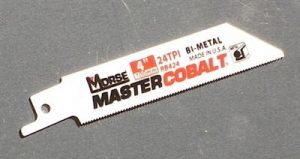Table of Contents
Introduction- What are reciprocating saw blades?
Reciprocating saw blades are the blades that come along with reciprocating saws. Reciprocating saws are cutting saws that are machine-powered to achieve cutting actions through a “push and pull” mechanism. This is where the name, reciprocating comes from. The saw blade has to be pushed through the metal or material and then pulled to cut through. Reciprocating saws have different types out of which include corded, cordless, compact, pneumatic, mini, plumbing, and HVAC reciprocating saws. The most used out of these reciprocating saws is the Cordless Reciprocating Saw.
Types of Reciprocating Saw Blade
Reciprocating saws do not just use any type of saw blade, they have their own blade types. These blades vary according to the specific material(s) they are used to cut through. The variations in these blades are mainly in their Teeth per inch(TPI), blade shape, and blade material. Then, let us look at the types of reciprocating saw blades in use today.
Woodcutting saw blade
The wood cutting saw blade is one of the most used around. This is because it is suitable for a number of purposes. It has 5-10 teeth per inch. This type of saw blade is used to cut through different types of wood materials. This blade would give you a fine, smooth cut through hard and softwood. Very effective. It can also be used to cut through plastic and other soft metal materials.
Combination saw blade
The combination saw blade is the most used reciprocating saw blade. It’s because it combines, as the name implies, two important cutting functions. The combination saw blade can cut through wood and metals conveniently. It has two common teeth per inch variables, 8-11 TPI and 10-14 TPI. They come with sharp teeth blades that would guarantee you a sharp cut in whatever material it is you are cutting through. So, if your job deals mostly with wood, you are good to go. If your job deals mostly with metal, you are also good to go.
Demolition saw blade
The demolition saw blade is most suitable for pulling apart already constructed wooden or metallic materials. If you have a wooden material in which a nail is embedded, the best saw blade to use is the demolition saw blade. The demolition saw blade is very heavy and built with sturdy materials. So, it’s very suitable for tedious work(s). It has a TPI of 6-11(TPI can be as high as 24 if needed depending on workload). You can also use a demolition saw blade for finishing cuts in wood, they cut smoothly.
Carbide tipped saw blade
The Carbide tipped saw blade is used to cut through ultra-heavy and thick metals. When you need to cut through dense alloys, cast irons, stainless steels, and the likes, you use carbide tipped saw blades. It’s the only carbide tipped saw blades that can cut through these ultra-thick metals. Carbide tipped saw blades are made with a super hard carbide that makes them withstand the ultra-tough nature of those dense materials.
Other specific reciprocating saw blade types are the diamond grit and pruning blades which serve specific purposes of pruning and smoothening stone-typed materials.
Conclusion
We have taken a good look at the types of reciprocating saw blades around and their particular use(s). However, we want to note that these saw blades cannot work effectively on their own. As mentioned in the introduction, reciprocating saw blades come along with reciprocating saws. So, they have to be attached to the reciprocating saw machine for effectiveness. Whether wooden, metallic or carbide tipped saw blades, reciprocating saw blades are made from durable and quality materials which enable them to carry out the particular function(s) for which they were made.

